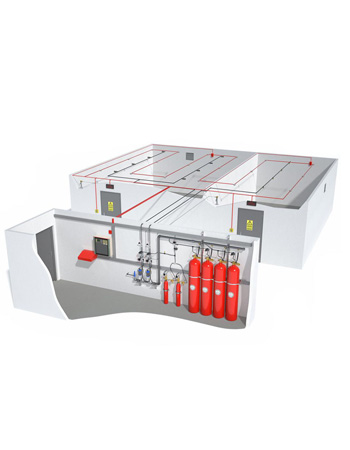Gas Suppression System

Gaseous fire suppression, also called clean agent fire suppression, is a term to describe the use of inert gases and chemical agents to extinguish a fire. These agents are governed by the National Fire Protection Association (NFPA) Standard for Clean Agent Fire Extinguishing Systems – NFPA 2001 in the US, with different standards and regulations elsewhere. The system typically consists of the agent, agent storage containers, agent release valves, fire detectors, fire detection system (wiring control panel, actuation signaling), agent delivery piping, and agent dispersion nozzles. Less typically, the agent may be delivered by means of solid propellant gas generators that produce either inert or chemically active gas.
Safety precautions
Suffocation
Warning sign for fire suppression system
An extinguishing system which is primarily based on inert gases in enclosed spaces presents a risk of suffocation. Some incidents have occurred where individuals in these spaces have been killed by carbon dioxide agent release (only in the case of CO2 carbon dioxide systems). When installed according to fire codes the systems have an excellent safety record. To prevent such occurrences, additional life safety systems are typically installed with a warning alarm that precedes the agent release. The warning, usually an audible and visible alert, advises the immediate evacuation of the enclosed space. After a preset time, the agent starts to discharge. Accidents have also occurred during maintenance of these systems, so proper safety precautions must be taken beforehand.[1]
Barotrauma
Barotrauma is physical damage to body tissues caused by a difference in pressure between a gas space inside, or in contact with the body, and the surrounding environment.[2] The positive pressure caused by these gases may be sufficient to break windows and walls. Humans and structures must be adequately protected and ventilation/blow-off must be considered when designing the system.
